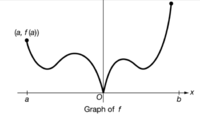onesun0000
Junior Member
- Joined
- Dec 18, 2018
- Messages
- 83
my first guess to the question was 4 because there would be 4 tangent lines parallel to the secant connecting the two end points. Then my second guess is none. No value of c can make derivative of the function equal to its average rate of change because no tangent line will be parallel to the secant and besides there is a sharp part of the graph where the function is not differentiable. I am not sure what the correct answer is.


A. Zero
B. Two
C. Three
D. Four

A. Zero
B. Two
C. Three
D. Four
Last edited:
